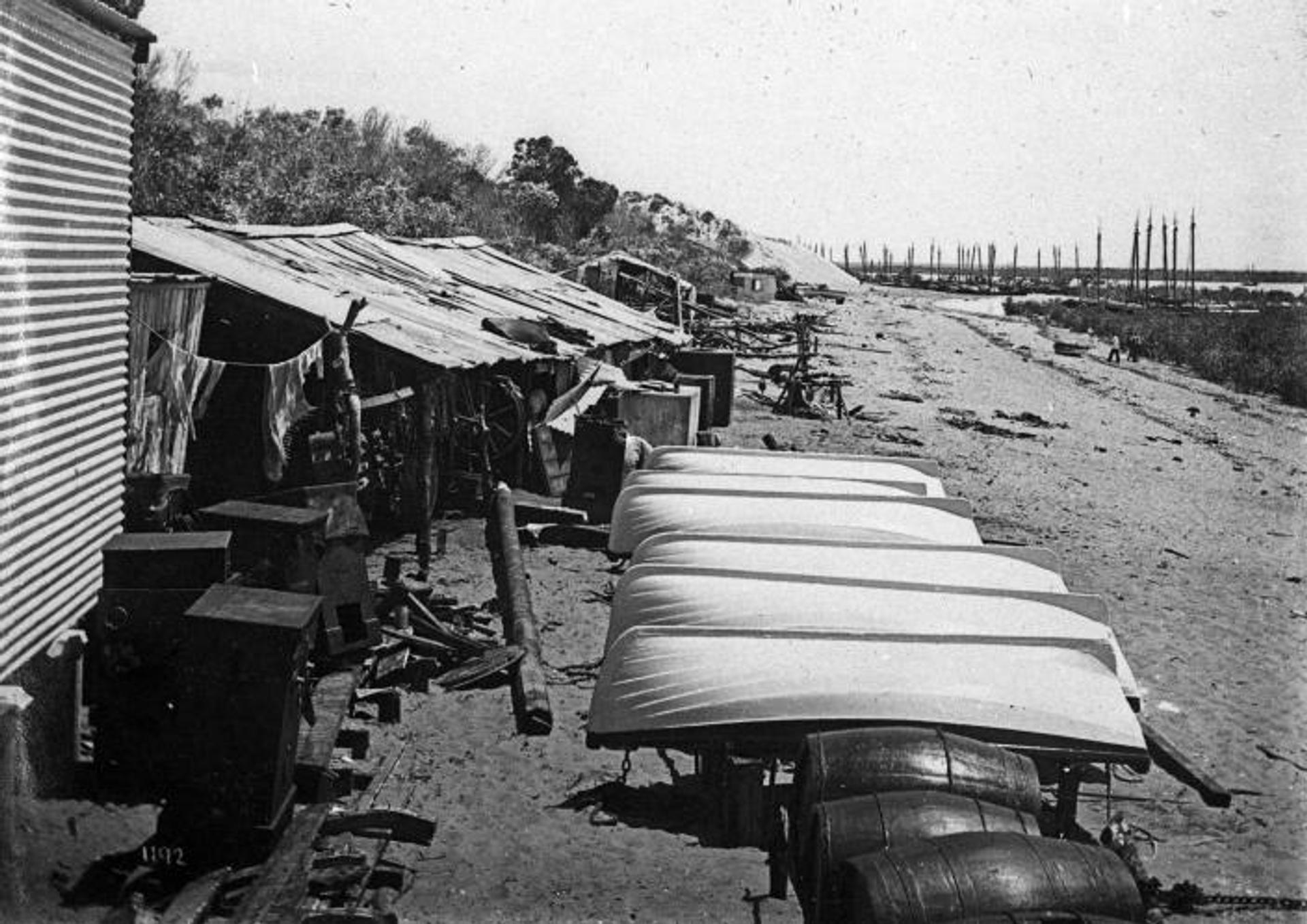Houssein
Vessel Name: Alto
Houssein, diver
Murdered, body buried at Wallal
26 December 1896
Alto
Captain Morgan Nelson, master
T.H. [Old Tom] Lucas, mate
W.H. Bartlett, cook
J. Neilsen, crew member
T. Lucas, crew member
Unknown number of pearl boat crew men from Hong Kong
Disappeared at sea, no bodies found
1 March 1920.

The Alto

An example of a lay-up camp
Alto was a 91 ton two-masted topsail schooner. She was 80.5 feet long [24.5 metres], 22 ft wide [6.7m] and had a draught of 8.3 ft [2.5m]. She was built in Port Macquarie, NSW by Edward Davies 1885 for Captain Frank Biddles.
On 26 December 1896 several pearl boats were moored at Wallal in their lay-up camps. Wallal had a fresh water well, a telegraph station, and was on 90 Mile Beach (now 80 Mile Beach), so it was a popular lay-up area for many schooners and their luggers along the northwest coast.
Alto was one of the boats laid up with her crew ashore. Most were Malays. They were drinking on the beach and enjoying their free time, earned from a profitable season pearl shelling.
A fight broke out between some of the Malay men. In the melee it was hard to see what was happening until a man was killed. He had six knife wounds and his torso had been driven through with a crowbar. He died quickly at the scene. His body was wrapped in calico and buried in the sand near the lay-up camps.
Captain Biddles was aboard the Alto later that day when he was later visited by a Malay man called Maximo Mendalian, who had had several cuts on his body which were bleeding badly. He said he had killed Houssein in self-defence. Captain Biddles dressed his wounds and then placed him in chains and called for police to investigate Houssein’s killing.
There were some witnesses who came forward. Herrope, another Alto crew member, had gathered two sticks and a crowbar from the beach and taken them to his tent after the fight. He produced them for police. They had blood stains on them.
Houssein was disinterred for Dr House to perform a thorough investigation into the cause of death and formal identification by Captain Biddles. Two of Houssein’s wounds were fatal. One was a stab wound that pierced the top of the heart, and the other was a deep four inch [10.16cm] head wound. He was buried again.
Three Malay men were arrested for the killing, including Maximo Mendalian. They were transported to Roebourne prison. Constable Buckland submitted a report to the Police Commissioner.
Roebourne’s Resident Magistrate presided over the trial, and the three men were charged with murder and held in custody. Meanwhile, the news travelled south to other settlements via the steamship Albany.
Mendalian was found guilty of Wilful Murder in January 1897. The other two men were released with their charges dismissed because of a lack of evidence of their involvement. Most Malay fishermen wore a keris with along blade [sheath knife] on their belt, so it was not possible to identify the other men.
Although Mendalian was found guilty of Wilful Murder, he was not hanged. The killing was part of a larger fight, and the jury petitioned for mercy. Mendalian was incarcerated with hard labour, although the length of his prison term is unknown.
By 1896 Alto was 11 years old, a good age for any pearl boat in the 1880s, especially one that had travelled the northwest coast in the pearling trade. Alto seemed to have nine lives, escaping cyclones, incidents and damage. She had several owners during her lifetime. In 1902, Captain Frank Biddles sold Alto to Goldstein & Co. for pearling. That company sold her to Mark Rubins.
Alto was not officially registered until 1900 and was numbered 13/1900. Her official number was 83796.
On 23 October 1901, Alto was approaching the wharf at Broome, when a Chinese cabin boy dived overboard to rescue a pet dog that had fallen into the water. He had just reached the surface when Alto crashed into the jetty, smashing two other boats, and pinning the boy to one of the piles supporting the wharf. He was taken to Broome hospital but died from his injuries. His name was not recorded in the very brief newspaper reports about the incident. This is another tragedy, with an unnamed lad who lost his life in the pursuit of commercial fishing and may never be identified.
On 17 June 1905 Alto hosted the diver and master of the Cleopatra in order to weigh a large (44 grains) $1000 pearl they had found. The story of that pearl was featured in newspapers for the next 12 months. It was stolen, a pearl buyer was murdered, and three crew men were hung. (See The Liebglid Pearl Murder story).
In May 1908, Alto was featured in Western Australian newspapers as the heroic boat that rescued the survivors of the wrecked Karakatta. And later in the same year, she was known as the last boat to see the Ethel before mutineers murdered the master and stole her away [See the Ethel story].
On 10 December 1908 the Alto was wrecked in cyclone seas 51 miles south of La Grange. Captain Rantzau, the mate T.H. Lucas, the cook W.H. Bartlett and crew members T. Burns and J. Neilsen all survived. Alto was salvaged and rapidly repaired and trading again by the start of 1909. That crew remained with the Alto for the rest of her days, with the usual rotation of masters.
In February 1909 the Paroo docked at Broome with a deceased crew member aboard. The master had seen enough illness to know this was smallpox, and a doctor brought aboard confirmed it. Pearlers petitioned the government for urgent permission to use the Alto as a quarantine station, as the Paroo carried new crews for Broome. Permission was granted and Alto was isolated and became a quarantine station for the next three months. Alto was 23 years of age and owned by James [Jim] Raynor.
Alto was caught in a cyclone in December of 1909, along with a large number of pearling vessels. Under master Captain Stuart, she was collecting shells from her fleet of luggers in deep water. The storm struck suddenly and many vessels were lost. Alto sustained damage which should have seen her out of action for months. Captain Stuart was an experienced master, and when Alto dragged her anchors, he hung oil bags on the weather side of the boat and ran for the beach when it was clear the boat could not survive at sea. Alto rescued crew from less fortunate boats, and they were cared for aboard. Alto’s crew also helped bury 17 men who drowned in the cyclone. Captain Stuart left 8.5 ton of pearl shell on the beach and returned to collect them when Alto was fully repaired. She was back at work within three weeks.
On 10 October 1910, Jim Raynor ordered Alto into the Boodarie Landing (between Port Hedland and Condon) to load bales of wool. Schooners carrying pearl shell usually had cargo and passengers aboard as a secondary income. The wool trade from Condon and Carnarvon was proving lucrative for schooners who travelled the northwest coast. Alto was driven onto the Red Bank in the Creek by a strong easterly wind. As the tide rose, she heeled, filled with water, and the wool bales floated free. She was righted and the wool saved. By now Alto was rumoured to be indestructible. Captain Spink sued Jim Raynor for a month of wages £12, and £12 in lieu of notice when he was fired for neaping the vessel. He was awarded £7 10s. and both parties had to pay their own court costs.
In March 1912 Alto was driven ashore in a cyclone while she was under repair at the Port Hedland jetty. Her crew managed to refloat her, and she continued as the mother boat to her small fleet of luggers, and a well-known coastal trader. Alto was a “softwood” schooner, made from wood which was faster to work with. Many schooners and luggers were made from soft wood in the hectic manufacturing times at the peak of the northwest pearling days.
On 26 March 1913 there was a major cyclone on the northwest coast, and many luggers and schooners were wrecked, damaged or lost. Alto was sailing from Carnarvon to Fremantle in ballast and was caught in the southeast gales that lasted for three days. There was no sighting of her for the next two months, and she was missing for two months. Newspapers reported there was no longer any hope of her survival. In May 1913 Captain F. Schroeder, an accomplished master, sailed her to the Gascoyne River mouth. She had been missing for three months. Her bobstay had been carried away, the bowsprit lifted and broke all its fastenings, both masts snapped, and her entire rigging went overboard with her sails attached. The crew saved the foresail boom and jury rigged a mast, and Alto limped south. She had been pushed 300 miles out to sea.
In 1916, Alto sank at her moorings in the river between the rail and traffic bridges in Perth. She was repaired by Mr A.E. Tilley of Fremantle and made watertight. He re-built her hatches, so they were above the waterline and refloated her. She was sold to A. Strang for £2,500 and returned to work with Captain Rantzou as master.
Finally, at the grand old age of 33 years {1918) Alto was bought by Captain Morgan Nelson of Fremantle. She was re-fitted as a two-masted [fore and aft sail] schoone. With T.H. [Old Tom] Lucas as mate, W.H. Bartlett as the cook and long-term crew members, J. Neilsen and T. Lucas, Alto set off for Hong Kong to pick up new crews for Broome pearling vessels. The crew were Fremantle residents. Old Tom was ex-navy prior to his many years aboard Alto.
At the age of 34 years, on 3 February 1919 Alto left Fremantle bound for Carnarvon and Point Cloates to collect whale oil and bones. She was then bound for Hong Kong to sell her cargo and collect new crews for Broome’s pearling vessels. In Hong Kong there is evidence owner A. Strang spent £1,400 on repairs to his boat.
Alto left Hong Kong to return to Broome with replacement crews and was never seen again. No sign of wreckage was ever found. She simply disappeared with her crew.
There was a substantial wait before newspapers reported her lost. After all, she had survived so many times before. After 112 days, however newspapers stated that Alto was officially lost. She was de-registered by authorities, using the date of her disappearance as 1 March 1920. Fremantle mourned her crew, because they had lived locally for most of their lives.
In August 1919, there was a glimmer of hope when a half-pound cocoa tin was found on a North Fremantle beach by a beach-walker Mr Fred Walters, and handed to police. The waterproof tin held a hand-written message, claiming to be from the crew of the Alto. It stated the crew were stranded on a reef at 30 degrees latitude, Alto had lost her rudder and asked for relief to be sent. The message was discounted as a hoax, mostly because it was not dated.
